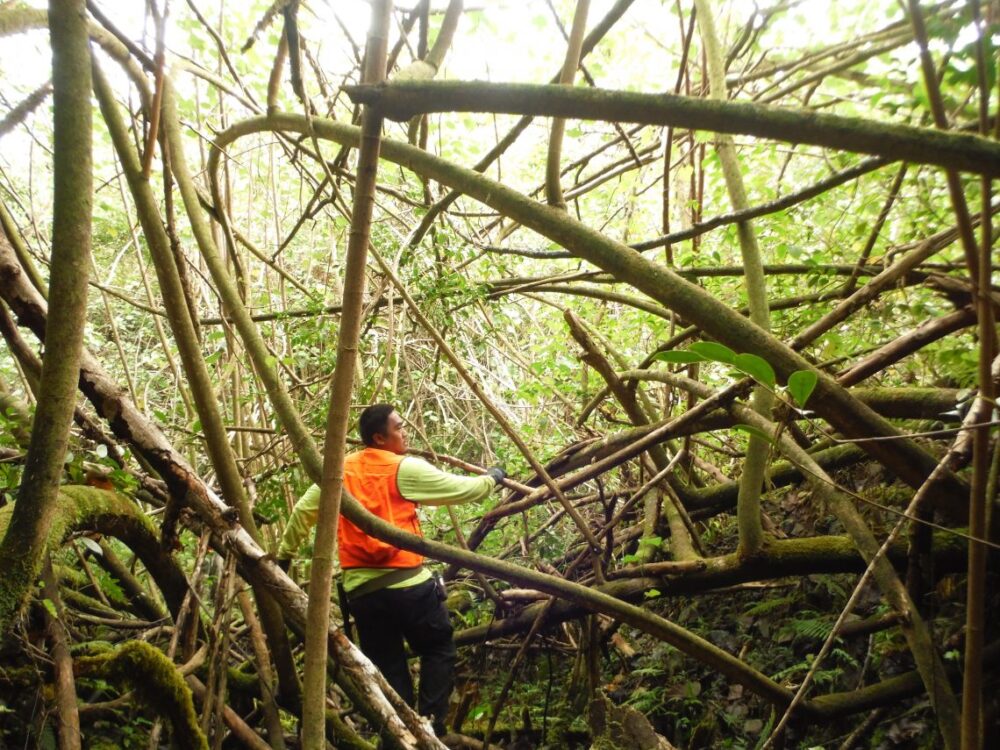Posted July 14, 2015 by Rachel Smith
As previously stated in the “Walking the Line” blog posted July 2nd, I would expand in detail about how we implement the practice of Integrated Pest Management (IPM) when controlling invasive species. This is #2 of the 4 part blog series!
When considering new introductions of invasive species, the goal at KISC, (of course) is to eliminate them entirely. The IPM process allows us to manage pests properly while on the path to complete eradication. IPM combines various forms of control, instead of relying on just one tactic. However, if we are able to manage and eliminate an invasive species by using just one of the control methods, the first strategy we use is manual control.
If an incipient species population is detected early enough, meaning there is only a small quantity and they are not yet mature plants, we prefer to, and can easily use manual control.
Just so everybody is on the same page, manual control = pulling weeds!
BUT, this is not your average backyard weed pulling, some of the weeds we pull are 15ft tall trees! Miconia, for example is one species that we first use manual control, and then if we find a plant that is too large to pull, we use chemical control. Miconia is a tree native to Central America that can grow up to 50 feet tall and completely take over a forest, forming a monotypic stand. Although this plant has a voracious appetite for consuming the forest canopy area, it happens to have an extremely shallow and weak taproot, making even a 15ft tall tree easy for just one person to remove by hand. Essentially we can manually remove almost all of our target species, as long as they are young enough. Once a plant reaches a certain level of maturity, we use other methods of IPM.
The KISC crew often trudges through treacherous terrain; steep cliffs, bogs, and dense forests dominated by webs of 30ft tall Hau bush and uluhe. They take on every type of terrain in all weather conditions, with the goal of finding incipient populations that can be removed by hand. Even though the work can be arduous, it is worth it to be able to survey an infested site, up close, and have the opportunity to use manual control before having to introduce herbicides to the area. There are quite a few plant species on the KISC target list where manual control proves to be most effective. If we can pull and entire plant, including its root system out of the ground, we can assume it is 100% dead. It may have dropped seeds before it was removed, but the risk of same plant re-emerging or forming new growth, is much lower with manually pulling, than chemically treating.
If manual control is not applicable, the next method we implement is mechanical control. KISC uses this method when removing a particular species that is too dangerous because of either terrain, and nearby canopy growth (meaning risky brittle Albezia branches), or because the plant itself is simply too dangerous to handle by hand. This is the case with the KISC target species Long Thorn Kiawe. This plant is gnarly. Long Thorn or LTK is a tree currently found along the coastal area of Mana, and has 4” long thorns that can puncture a truck tire!
Currently, the entire LTK population along the coast at the Pacific Missile Range Faculty is being controlled by the use of a hydro-ax. This hydraulic-ax is a heavy duty brush mower that makes clearing dense thickets much easier and especially, quicker than manual cut and chemical treatment. After the whole area is hydro-axed, the KISC crew will then use the combination of mechanical and chemical control to remove any large stumps left behind, and then continue to survey the area every few months and manually remove any new LTK seedlings that are left in the seed bank. KISC occasionally uses mechanical or manual control, in combination with chemical control. We use this combination for management of species that have extremely intricate root systems, as well as plants that can form new growth from even the smallest cutting. (please look for more information about the herbicide techniques we use in the next blog!)
The manual and mechanical control methods certainly require endurance, muscle, and a certain level of tolerance for wearing dirt, sweat, and grime, but these tactics prove to highly effective in managing and eradicating invasive species.





